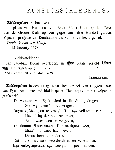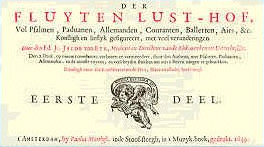Hermanus van Eyck
The Hague 1637 - The Hague 1678
click to explode the image
(a poem in dutch)

Hermanus van Eyck was a carillon player at the St-Jacob church, also known as the 'Grote Kerk' (= Great or Big Church) in the town of the Hague.
In a poem of remembrance, written by the the grand dutch poet, Constantijn Huygens, the brother of the scientist Christiaen Huygens, the inventor of the pendulum clockwork and the first president of the Académie Française, Hermanus was mentioned as being murdered by gunfire. The poem mentions several murderers.
Huygens poem speaks about a man who died 50 years to early, (Hermanus was about 40 or 41 years old), but who didn't need those 50 years, not even one more year, to prove his 'perfect honour' (concerning his music).
He already had merited this honour, thanks to 'his pair of incomprehensible and unequalled hands'.
In a very old-fashioned dutch, Huygens tells us that all artists were struck silent before they regained control over themselves, hearing the news about the killing of Hermanus van Eyck.
(NA1879)
On Jan 13th 1678 a certain Pieter Pater becomes the carillon player of the curch in The Hague, earning 300 guilders a year "like Van Eyck".
A few years later (in 1682) Stephanus Cosijn, already organ player at the church since 1680, becomes the carillon player. He held both positions until 1697, possibly the year of his death. We do not know a great deal about the intermediary Pieter Pater, but Stephanus Cosijn was a painter, a draughtsman and a musician with relations to several royal courts, just like Hermanus van Eyck and his family.
Stephanus worked for Queen Mary II in 1685-1688 as a still life painter and probably illustrated a catalogue with plants from the royal gardens of Honselaarsdijk Palace.
(HS295)
Hermanus' unusual vocation poses some unanswered questions, as at the same time another carillon player, Jacob van Eyck, plays the chimes of the largest church of Holland, in the town of Utrecht.
This Jacob was blind, which didn't keep him from composing some pieces of music, for instance 'Der Fluiten Lusthof' (= Paradise of the Flute, or, The Garden of Joy of the Flute).

Probably, the carillon player Hermanus had a brother Jacob or Jacobus, who by no means can be the composer. The birth certificate of Hermanus possible brother, Jacob(us), hasn't been found, but at the marriage of this Jacobus, the second husband of Hermanus' mother is a prominent witness (a best man), so, the relation between Jacobus et Hermanus could well be a relation of two brothers.
Other sources (NA1879) speak about a family relation between the family of the carilon player in Utrecht and the Huygens family. The family of the Utrecht carilon player is an old nobel family from the province of Brabant.
On the contrary, the father of the carilon player in The Hague was a pharmaceutical chemist, who was born in the town of Leyden, where we find yet another 2 or 3 preceding generations of phamaceutical chemists by the name of Van Eyck. It seems improbable that one can find ancestors of the carilon player of The Hague in the province of Brabant. One has to mention that the birth certificate of the father of the carillon player of The Hague haven't (yet) been found in the archives of the town of Leyden.
Still, it is a strange coincidence of two carilon players, who both go by the name of Van Eyck, both play at two of the most important dutch churches, both have relations to the important family of Constantijn Huygens (secretary of three consecutive princes of Orange, stadholders and therefore the most important persons in Holland.) and both coming from a family Van Eyck in which the name Jacob is a common one.
links:
his sister's husband Gerrit de Hoog
List of all artists
Family Tree
Universal Page


